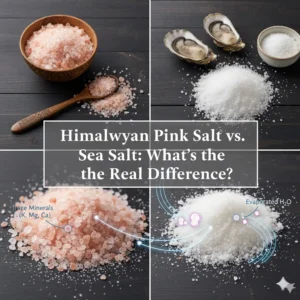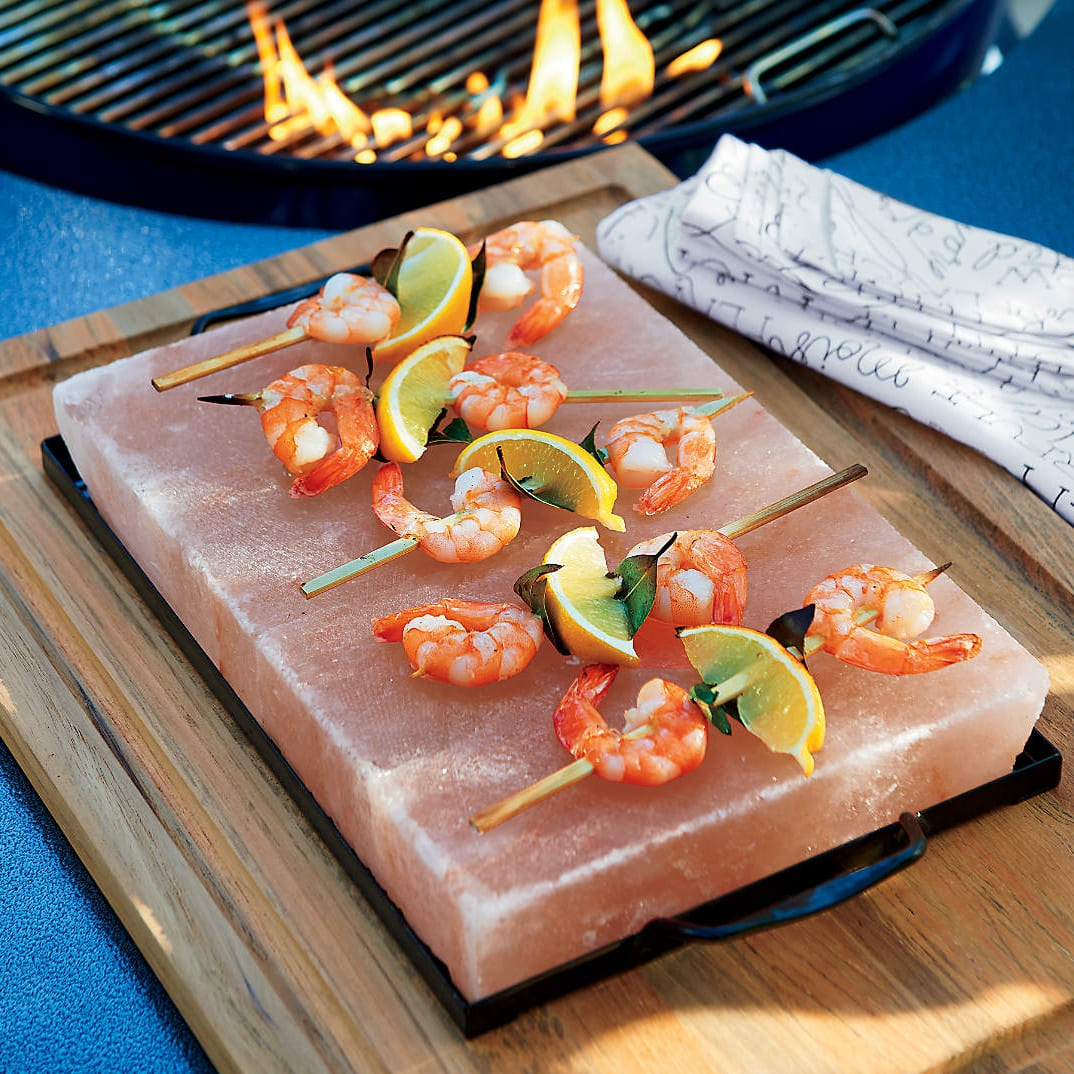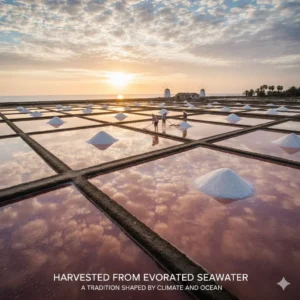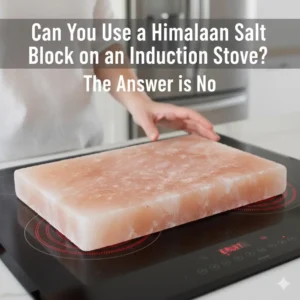Himalayan pink salt and sea salt are both unrefined salts valued for their mineral content and natural origins, yet they differ notably in how they’re formed and used. Understanding these differences helps chefs, nutrition-focused consumers, and product developers choose the right option for flavor, purity, and sourcing transparency. This article compares their origins, mineral composition, and culinary roles to clarify which salt best matches your cooking, health, or formulation goals.
Himalayan Pink Salt vs. Sea Salt: Core Differences at a Glance

This table summarizes the key differences between Himalayan pink salt and sea salt in terms of origin, mineral content, processing, flavor, and potential health considerations.
| Feature | Himalayan Pink Salt | Sea Salt |
|---|---|---|
| Origin | Extracted from ancient mineral deposits in Pakistan’s Khewra Salt Mine, isolated from modern ocean pollutants | Derived from evaporated seawater; quality varies with marine environment and may be influenced by microplastic presence |
| Mineral Content | Contains trace minerals including iron oxide, which imparts its distinct pink hue | Provides magnesium, calcium, and potassium; composition differs by regional source |
| Processing | Physically mined and minimally processed, preserving its natural mineral balance | Typically washed or refined; some mineral loss may occur during processing |
| Taste | Mild flavor with subtle earthy or slightly sweet undertones | Briny, oceanic flavor with varying textures from fine to flaky |
| Health Considerations | Primary concern is sodium intake; generally free from microplastic contamination | Potential exposure to microplastics depending on source; sodium moderation recommended |
What Is Himalayan Pink Salt? Mineral Composition and Origin
Geology and Mining at the Khewra Salt Mine
Himalayan pink salt comes from the Khewra Salt Mine in Pakistan’s Punjab region—one of the world’s oldest and most renowned sources of natural salt. The deposits formed through the evaporation of ancient seawater millions of years ago, long before modern industrial activity. Because these geological layers have remained sealed over time, the salt retains remarkable purity, free from contemporary ocean pollutants and microplastics.
Extraction is purely mechanical, with no chemical refining or heavy processing. This approach preserves the salt’s natural crystalline structure and trace mineral content. Many attribute Himalayan salt’s chemical stability and clean taste to its protected, fossil-sea origin.
Mineral Profile and Physical Characteristics
The salt’s distinctive pink hue is caused by trace iron oxide, along with minute amounts of zinc and other minerals. These inclusions subtly influence both color and flavor, adding mineral depth without affecting its mild salinity. Himalayan salt crystals are dense and translucent, often sold as blocks or chunks suited for culinary, decorative, and wellness purposes.
Because it is mined rather than evaporated, the grains tend to be coarse and compact, making them ideal for grinder mills, cooking slabs, and therapeutic uses such as bath salts or lamps.
Premium Himalayan Salt Blocks for Culinary and Hospitality
Collaborate with Jilin Ever Creation for authentic, food-grade pink Himalayan salt blocks sourced directly from Pakistan’s Khewra Salt Mine. Choose from customizable sizes, shapes, and packaging to enrich culinary presentations, elevate retail design, and enhance hospitality experiences worldwide.

What Is Sea Salt? Harvesting Methods and Mineral Variations

Harvesting from Evaporated Seawater
Sea salt forms through the evaporation of seawater in salt pans or tidal pools, a process influenced by climate conditions and surrounding water quality. Because marine environments differ worldwide, the purity of sea salt varies accordingly. Some varieties, especially those from industrialized regions, may contain trace microplastic residues identified in recent studies.
Regardless of origin, sea salt remains a culinary essential known for its bright flavor and crisp texture. Producers often emphasize artisanal techniques or regional character to showcase distinctive mineral and taste profiles.
Mineral Composition and Flavor Characteristics
Beyond sodium chloride, sea salt contains small amounts of magnesium, calcium, and potassium that contribute to its clean, briny sharpness. Its texture ranges from fine granules to large, flaky crystals, adding both tactile contrast and savory intensity to food. These qualities make it especially valued as a finishing salt for meats, baked goods, and salads.
When left slightly moist and unrefined, sea salt develops a natural oceanic freshness that enhances seafood, vegetables, and other delicate dishes. Its mineral versatility and sensory appeal secure its place in both gourmet kitchens and large-scale food production.
Himalayan Pink Salt vs. Sea Salt: Head-to-Head Comparison
Taste and Culinary Uses
Himalayan pink salt offers a mild, rounded flavor suited to daily cooking or specialized presentations such as grilling on salt slabs. Its subtle earthiness complements meats, vegetables, and desserts without dominating the dish. Sea salt delivers a cleaner, more pronounced oceanic taste that enhances foods requiring distinct salinity, including seafood and salads. Many chefs favor its flaky texture for finishing dishes and adding a textural contrast.
In essence, Himalayan salt prioritizes gentle flavor and visual appeal, while sea salt emphasizes crisp texture and vibrant taste. The better fit depends on whether you value refined subtlety or fresh intensity in your culinary applications.

Health and Safety Considerations
Both salts consist mainly of sodium chloride, and excessive consumption can elevate blood pressure and cardiovascular risk. Himalayan pink salt is mined from sealed deposits, shielding it from marine pollutants and microplastics. Sea salt, derived from open waters, can vary in purity depending on harvest location. Choosing verified suppliers that test for contaminants helps ensure consistent quality.
Although trace minerals add visual and flavor interest, their quantities are nutritionally insignificant. From a health standpoint, moderation and balanced diet matter far more than differences in color or origin.
Cost and Availability
Himalayan pink salt typically commands a higher price due to manual extraction, transport, and premium positioning. Its value lies in both purity and aesthetic appeal, driving demand across culinary and wellness markets. Sea salt remains broadly available and cost-effective, especially in large-scale or refined forms for commercial kitchens and food production.
For home or professional use, the decision often reflects personal preference and budget rather than notable differences in functionality or nutrition.
The Final Verdict: Choosing Between Himalayan Pink Salt and Sea Salt
Himalayan pink salt is ideal for those seeking a pure, visually distinctive salt with trace minerals and a mild, balanced taste suited for culinary or spa applications. Its mined origin ensures consistent composition and absence of oceanic pollutants. Sea salt, by contrast, offers a bright, complex flavor and signature texture that make it the preferred choice for finishing dishes or large-scale seasoning.
Both varieties perform well when sourced and used thoughtfully. Evaluate your health goals, cooking methods, and sustainability priorities before deciding. The right choice balances function, flavor, and responsible use—qualities that transcend marketing claims and align with informed consumption.
Frequently Asked Questions About Himalayan Pink Salt and Sea Salt
Does Himalayan salt contain more minerals than sea salt?
Himalayan pink salt includes trace minerals such as iron and zinc, but their quantities are negligible compared to the overall sodium content. Sea salt also provides minor mineral traces that differ by source, so the nutritional contrast between the two remains minimal.
Do Himalayan pink salt and sea salt taste different?
Yes. Himalayan salt delivers a mild, earthy note with gentler salinity, while sea salt tends to taste sharper and more distinctly oceanic. Texture also influences perception—the coarser sea crystals create a more pronounced flavor burst.
Is one type of salt healthier than the other?
Neither salt type provides a meaningful health advantage when consumed in moderation. Both supply essential sodium but can be harmful in excess. Selecting unrefined, responsibly sourced salt helps reduce potential exposure to impurities such as microplastics.
Why is Himalayan salt pink?
The pink coloration originates from iron oxide and minute traces of other minerals present during the rock’s formation. These natural inclusions create its distinctive hue without the use of additives.
Is Himalayan salt better for cooking than sea salt?
It depends on the application. Himalayan pink salt performs well for seasoning or presentation, while sea salt’s flaky texture is preferred for garnishing and finishing dishes. Both can be used interchangeably in most recipes when measured by weight or volume.
Final Thoughts
Himalayan pink salt and sea salt each hold distinct strengths. The first offers geological purity and gentle mineral nuance, while the second provides vibrant texture and coastal brightness. Both enhance culinary experiences when used with balance and intention.
Understanding how their origins, mineral profiles, and flavor behaviors differ enables more purposeful ingredient selection. For reliable quality and authentic sourcing, partner with trusted suppliers such as Jilin Ever Creation, offering certified Himalayan salt blocks and refined culinary options suited to home, hospitality, and professional kitchens.






